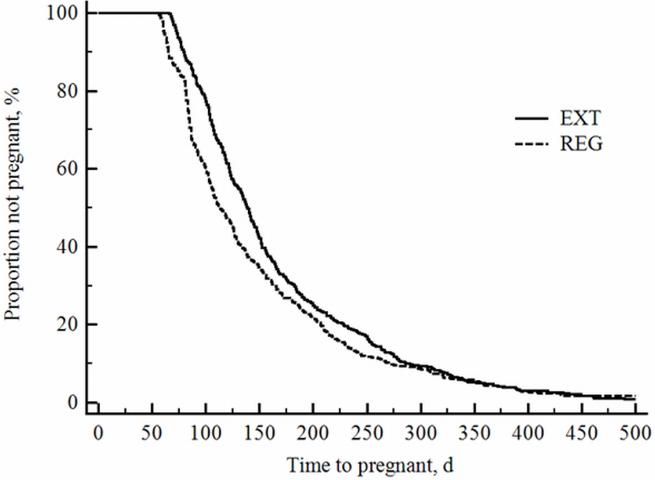The economic importance of voluntary waiting period
Reproductive performance and milk production are important factors that affect the profitability of a dairy farm (De Vries 2006; Galvão et al. 2013). Reproductive success in a dairy is typically measured by reproductive indices such as days open (DO), calving interval (CI), service rate, pregnancies per AI (PAI), and pregnancy rate. The voluntary waiting period (VWP), which is the time from calving to the start of the breeding period, is an important component of reproductive management because the VMP affects pregnancy rate, DO, and CI (Van Amburgh et al. 1997; Tenhagen et al. 2003).
Most dairy farms use a VWP of approximately 60 days in milk (DIM) (range from 30 to 90 DIM [DeJarnette et al. 2007]). In their survey of 673 herds in the United States, season was the second most frequently cited reason for altering the VWP (postpartum health [50%], season [18%], milk yield [18%], parity [14%], and other reasons [14%]). Among the herds that altered the VWP by season (n = 120), 63% (75/120) did so to avoid inseminating cows during the summer months, 22% (26/120) tried to avoid calving during the winter months, and 16% (19/120) tried to avoid calving during the summer (DeJarnette et al. 2007). The summers in the southeast United States are hot and humid, and cows experience decreased reproductive performance; therefore, some dairy farmers delay breeding until the cooler fall (Du 2013). However, there is no economic data to support this practice. Therefore, the objective of this article is to present the results of a recent paper (Gobikrushanth et al. 2014) that evaluated the effects that delaying breeding during the summer has on cow performance and profitability in Florida.
Evaluating the effect of delayed breeding during the summer on cow performance and profitability
Data from Holstein cows (n = 1416) that calved between June and September of 2007 and between June and September of 2008 were used. Cows that calved between June 1 and July 21 (regular group [REG]; n = 719) were artificially inseminated (AI) for the first time upon estrus detection (ED) after the second PGF2α of the Presynch administered between 57 and 63 DIM, or were timed AI (TAI) using the Ovsynch protocol if not detected in estrus. Cows that calved between July 22 and September 18 (extended group [EXT]; n = 697) were AI for the first time after the first or second PGF2α starting November 14 or November 21 or were TAI if not detected in estrus. For second and subsequent AI, all cows were AI upon ED or enrolled on TAI after non-pregnancy diagnosis. Following these schemes, average VWP in the REG group and EXT group were 60 and 83 DIM, respectively. Overall profitability for both experimental and subsequent parities were calculated by subtracting the costs existing for feeding costs ($0.30/kg lactating cow diet; $0.25/kg dry cow diet), breeding costs ($2.65/dose PGF2α; $2.40/dose GnRH; $0.25/injection administration; $10/semen straw; $5/AI; $3/pregnancy diagnosis), and other costs ($3/d) from the daily revenues with milk sales ($0.44/kg milk), cow sales ($1.76/kg live weight), and calf sales ($140/calf). A herd budget simulation was used to predict future cash flow after culling or end of subsequent parity until six years after start of study to account for all cash flow consequences of extended VWP. Cows in the EXT group had greater first service pregnancy per AI (37.7 vs. 32.1; P = 0.02), but still had greater mean days open (156 vs. 139 d; P < 0.001), median days open (139 vs. 113 d; P < 0.001; Figure 1) and calving interval (428 vs. 408 d; P < 0.001). Delaying breeding did not affect total cash flow, because the EXT group had greater (P = 0.05) combined profitability for the experimental parity and subsequent parity but lesser (P < 0.001) future cash flow (Table 1).

Credit: Adapted from Gobikrushanth et al. (2014)
Conclusion
Delayed breeding during the summer increased pregnancy per AI to first service but did not improve overall reproductive efficiency. Delaying breeding did not affect total cash flow for the six-year period evaluated. The decision to delay breeding during the summer in herds similar to the one used for this study may be based on other management considerations, because it did not affect overall profitability.
References
DeJarnette, J. M., C. G. Sattler, C. E. Marshall, and R. L. Nebel. 2007. Voluntary waiting period management practices in dairy herds participating in a progeny test program. J Dairy Sci 90: 1073–1079.
De Vries, A. 2006. Economic value of pregnancy in dairy cattle. J Dairy Sci 89: 3876–3885.
Du, F. 2013. Characterization of pasture-based dairy farms in Florida and Georgia. MS Thesis. Univ. Florida, Gainesville.
Galvão, K. N., P. Federico, A. De Vries, and G. M. Schuenemann. 2013. Economic comparison of reproductive programs for dairy herds using estrus detection, timed artificial insemination, or a combination. J Dairy Sci 96: 2681–2693.
Gobikrushanth M., A. De Vries, J. E. Santos JE, C. A. Risco, and K. N. Galvão. 2014. Effect of delayed breeding during the summer on profitability of dairy cows. J Dairy Sci 97: 4236–46.
Tenhagen, B. A., C. Vogel, M. Drillich, G. Thiele, and W. Heuwieser. 2003. Influence of stage of lactation and milk production on conception rates after timed artificial insemination following Ovsynch. Theriogenology 60: 1527–1537.
Van Amburgh, M. E., D. M. Galton, D. E. Bauman, and R. W. Everett. 1997. Management and economics of extended calving intervals with use of bovine somatotropin. Livest Prod Sci 50: 15–28.